

磁共振和磁感应技术:哪一个才是我们最好的应用选择?
Architects of wireless power transfer systems face a couple of choices in the configurations of coils and the magnetic transfer technique. The best choice depends on the application:
无线充电系统的设计构造有几个部分需要作出选择,即线圈参数设置和磁场转换技术选择。但是具体方案还是要根据不同的设备来确定:
选择1:发射线圈和接收线圈之间是使用松耦合还是紧耦合?
Inductive power transfer works by creating an alternating magnetic field (flux) in a transmitter coil and converting that flux into an electrical current in the receiver coil. Depending on the distance between the transmit and receive coils, only a fraction of the magnetic flux generated by the transmitter coil penetrates the receiver coil and contributes to the power transmission. The more flux reaches the receiver, the better the coils are coupled.
磁感应能量转换是通过在发射线圈里创造一个变化的磁场实现的,接收线圈将变化的磁场转换为电流。由于发射线圈和接收线圈之间的距离不同,只有一部分发射线圈产生的磁场能够被接收线圈吸收并转化为电能。在整个过程中,接收线圈收到的磁通量越大,则两个线圈耦合性越好。
A higher coupling factor improves the transfer efficiency, and reduces losses and heating. Applications with a larger distance between the transmit and receive coils operate, by definition, as a loosely coupled system. In loosely coupled systems, only a fraction of the transmitted flux is captured in the receiver. That means that loosely coupled systems have higher electromagnetic emissions, making them less suitable for applications with tight EMI or EMF requirements.
耦合性越高,线圈之间传输能量的效率越高,并且会减少漏磁和线圈的发热。在应用过程中,若发射线圈与接收线圈相距较远,则被称为松耦合系统(loosely coupled system)。在松耦合系统中,只有一小部分变化的磁场能被接收线圈接收,这就意味着松耦合系统会产生更多的电磁泄漏,因此不适用于对EMI和EMF高要求的应用场景。
Loosely coupled systems trade-off larger distance at the cost of lower power transfer efficiency and higher electromagnetic emissions. This may be suitable choice in applications where tightly aligned coils is impractical, but less suitable for applications with tight EMI or EMF of efficiency requirements.
松耦合系统可以调节长距离,低效率和高电磁泄漏三者之间的关系。这使松耦合系统可适用在“紧耦合的线圈阵列”不可行的应用场景,但是对于EMI和EMF要求过高或者对效率要求过高的应用场景,松耦合系统则很不适用。
Tightly coupled systems, because of their higher efficiency, tend to produce less heat which is an advantage is products with tight thermal budgets such as modern smartphones.
紧耦合系统,由于能量传递更高效,因此产生热量较少,适合对发热控制要求较高的设备,例如我们常用的手机等。
For the definition of coupling factor see:
另外关于耦合相关系数的解释请参见以下网页:http://www.wirelesspowerconsortium.com/technology/coupling-factor.html
The transmit and receive coils are tightly coupled when (a) the coils have the same size, and (b) the distance between the coils is much less than the diameter of the coils.
当发射线圈和接收线圈大小相同,并且线圈之间的距离远远小于线圈直径时,就会产生紧耦合。
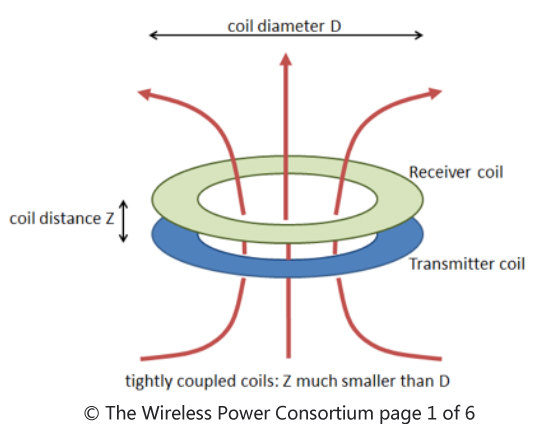
Loosely coupled coils or operate with significantly different coil sizes, or operate at larger distance.
当发射线圈和接收线圈尺寸有明显差距或者距离很远时,会产生松耦合。
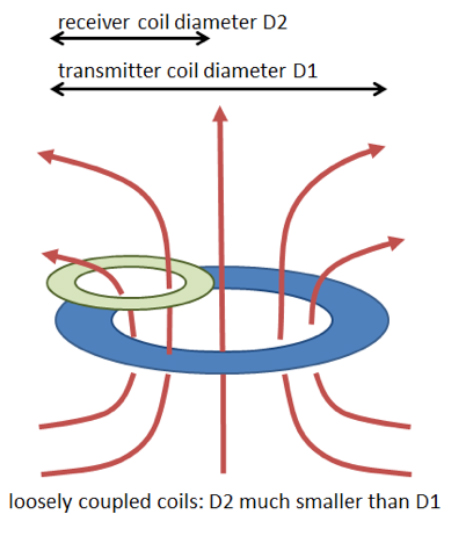
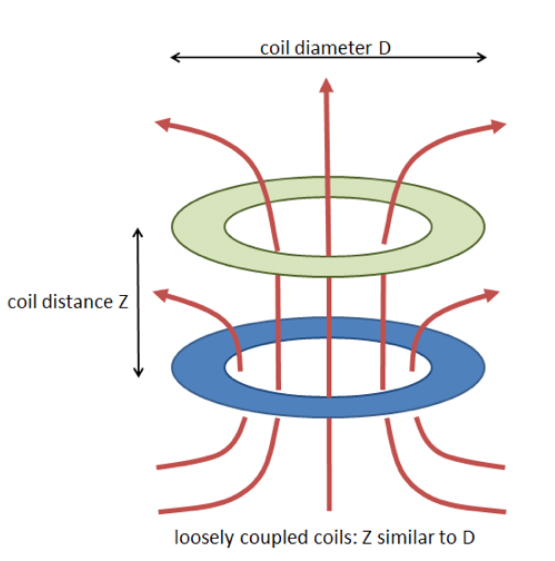
Choice 2: Operate the coils at resonance or off-resonance?
选择2:使线圈处于磁共振状态,还是非磁共振状态?
From the beginning of inductive power transmission, resonant circuits have been used to enhance the efficiency of power transmission. As early as 1891, Nicola Tesla used resonance techniques in his first experiments with inductive power transmission. Systems with a low coupling factor generally use a resonant receiver and resonant transmitter to improve power transfer efficiency.
在早期的磁感应能量传输系统中,共振电路就被用来提高能量传输的效率。早在1891年,尼古拉-特斯拉就将磁共振技术应用在磁感应能量传输中。通常在弱耦合系统中,使用共振的接收器和共振的发射装置以提高传输效率。
For technical details see:
技术背景请参考以下网页:http://www.wirelesspowerconsortium.com/technology/resonant-coupling.html
You might expect that operating tightly coupled coils at resonance offers the best performance. That combination, however, is not used in practice because two tightly coupled coils cannot be both in resonance at the same time. This is one of the counter-intuitive effects that make power electronics such an interesting subject.
你可能十分期待,将紧耦合技术与共振原理相结合以得到最好的能量传输效率。但是,紧耦合+磁共振,并没有在实际中应用,因为紧耦合线圈不能同时产生共振。这是电力电子科学中一个比较有趣的反直觉效应。
Most Qi transmitters use tight coupling between coils. In that configuration, the best results are achieved by operating the transmitter at a frequency that is slightly different from the resonance frequency of the Qi receiver. Off-resonance operation gets you the highest amount of power at the best efficiency.
大多数Qi充电器通过线圈之间产生的紧耦合运转。在这样的前提下,最好的结果就是调节发射端的工作频率,使其与接收端的共振频率有一点细微的差别。因为无法达到共振频率,只能无限接近。非共振传输会提供最强最高效的表现。
chioce3: Single coil or multi-coil?
选择3:单线圈还是多线圈?
Tightly coupled coils are sensitive to misalignment. That’s why most Qi transmitters use multiple coils. This increases the complexity of the transmitter design, but improves the horizontal (X, Y) freedom of positioning. Coil arrays can cover large areas. See, for example, ConvenientPower’s WoW5 transmitter.
紧耦合线圈对线圈之间的对准程度要求很高。这就是为什么大多数Qi充电器使用多线圈的原因。多线圈极大地增加了充电器的设计要求,但是接收端就有了更强的平面自由度,不用太注意线圈之间对准的问题。线圈阵列可以覆盖很大的面积,比如ConvenientPower公司的WoW5无线充电器。
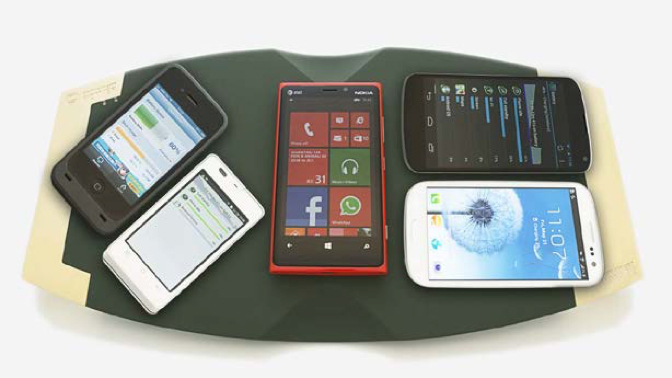
Another advantage of multi-coil systems is that they help localize the magnetic flux, reducing EM emissions, and make it possible to charge multiple receivers concurrently.
另一个多线圈的优势在于更好的聚集磁通量,减少电磁场泄露,使多设备同时充电成为可能。
Here are some examples of transmitters that use overlapping coils
下面是一些应用重叠线圈的无线充电器
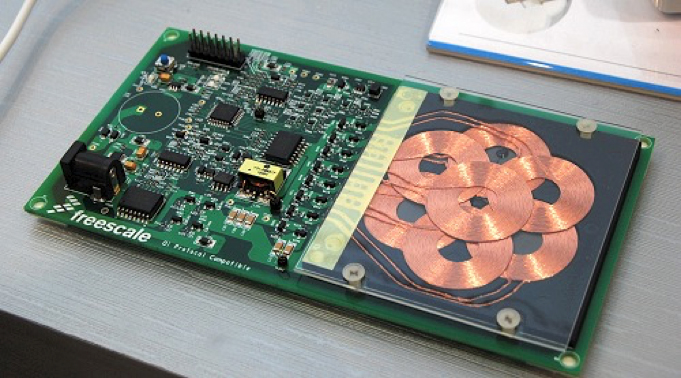
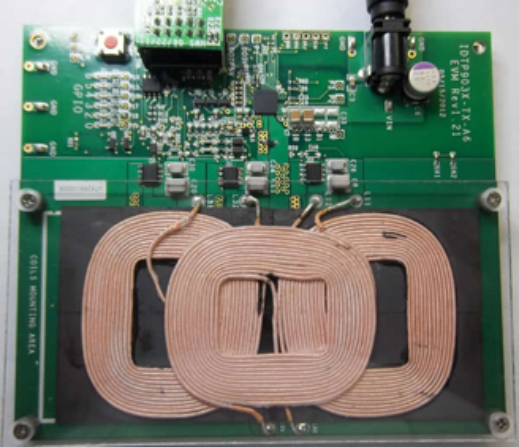
Coils don't need to overlap either. Solutions with non-overlapping coils can be easier easy to assemble.
当然线圈也并不是必须重叠放置,“无重叠方案”可以更方便无线充电器的组装。
Multi-coil transmitters can charge several receivers at the same time, simply by powering the coils underneath the receiver.
多线圈充电器只需要给里面的线圈供电就可以做到同时给多个设备充电。
Multi-coil transmitters also allow the wireless power ecosystem to scale with increasing power levels that devices demand, by powering multiple coils underneath the receiver. The first smart phones needed 3W, todays require over 7.5W and growing. We also now have tablets, ebooks readers, ultrabooks which need from 10-30W. Multi-coil systems transmit the power exactly where it is needed in a safe, efficient and controlled manner guaranteeing scalability as devices get more and more power hungry.
多线圈充电器只需要加强给线圈的能量就可以加大充电的功率,以适应多种设备的功率要求。最早的智能电话需要3瓦来充电,现在需要超过7.5瓦而且还在增长。平板电脑,电子书,超级本会需要10到30瓦的电量。多线圈充电器可以安全有效的控制供电,并且扩展性极强。
A loosely coupled system can achieve multi-device charging with a single transmitter coil, provided it is much larger than the receiver coils and the provided the receivers can tune themselves independently to the frequency of the single transmitter coil.
松耦合系统可以用一个发射线圈达到为多个设备充电的需求,但是要求发射线圈远远大于接收线圈,并且要求接收装置都能够单独调节自身的频率以适应发射线圈的频率,
The table below provides a summary of the possible transmitter configurations:
下面的表格提供了所有可能的充电形式:
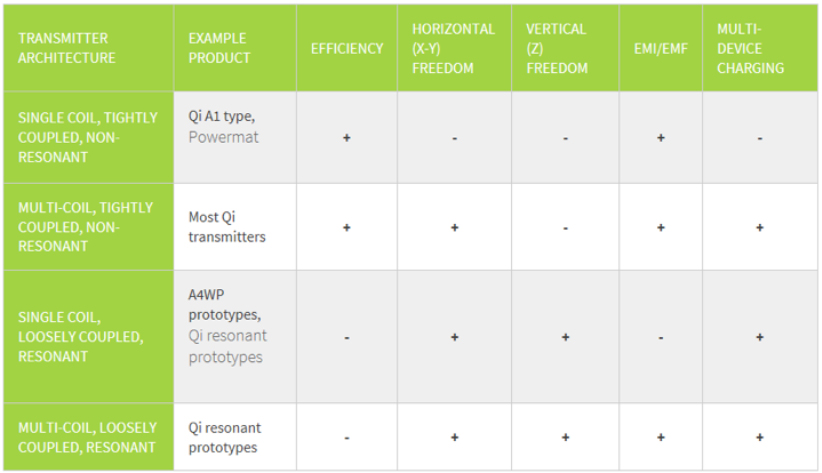
As you can see, there is no optimum design. The choice of architecture will depend on the application requirements. Is efficiency important? Is EMI (electromagnetic interference) a concern? Do you need a large Z distance? Is cost the key issue? Depending on your priorities, the optimum will be different
可以看到,并没有最完美的设计。工程师会根据不同的应用场景选择其结构。是效率重要?是考虑EMI?还是需要更大的线圈间距?成本是不是重要的因素?对上述各因素的考虑优先级不同,最优设计的方案就不同。
Qi gives you the possibility to choose what is best for your application
Qi提供了让你选择最适合你的可能性。
All Qi receivers have a well-defined resonance frequency and can operate at resonance. The Qi transmitter products that are in the market today operate off-resonance, with tight coupling, because that combination provides both high power transfer and high efficiency. Most Qi transmitter products use multiple coils because they provide a better user experience.
所有Qi接收器的共振都有明确的共振频率,并且线圈都是可以被调节在共振的状态中。如今市场上的Qi充电器选择紧耦合、非磁共振是因为这样的结合能提供最大,最高效的能量传输。大多数Qi充电产品使用多线圈方案是因为能提供更好的用户体验感。
At the Consumer Electronics Show in January, and at Mobile World Congress in February, you could see the first Qi transmitter products that operate at larger distance, loosely coupled, and at resonance. These resonant Qi transmitters are compatible with all Qi phones out there today. Otherwise we would not call it a Qi transmitter: If you see the Qi logo, you can be sure that the product is compatible with all other Qi products.
今年一月份的消费者电子展上,二月的世界手机大会,我们看到第一款可以远距离供电的松耦合、共振充电设备。这些磁共振Qi充电器可以与如今所有Qi手机匹配。否则的话也不能叫做Qi充电器:如果你看到Qi的标志,你大可放心,这个产品一定会与你的Qi手机匹配。
A4WP
The Alliance for Wireless Power offers only one choice: “single coil, loosely coupled, resonant”. That configuration is not optimal for all applications. The WPC believes that product developers need more options to choose from. The solution “single coil, loosely coupled, resonant” is just one of the options offered by the Wireless Power Consortium.
A4WP无线充电标准只提供了“单线圈,松耦合,共振”的选择,但是这样的设计并不适用于所有的应用场景。WPC相信产品研发者需要更多选择。然而,单线圈,松耦合,共振的方式只是其中一种。
The solution offered by the A4WP is not compatible with the millions of Qi phones and tablets that are already in the market. The WPC has demonstrated that it is possible to make loosely coupled resonant transmitters that are compatible with all these of Qi phones and tablets. There is no technical justification for incompatibility.
A4WP的解决方案并不适用于如今已在市场上的千千万万的Qi手机和手提电脑。如今,WPC已经演示了未来这种松耦合、单线圈、磁共振的解决方案,并且会和你的Qi手机以及平板电脑匹配。


官方微博

微信公众号








